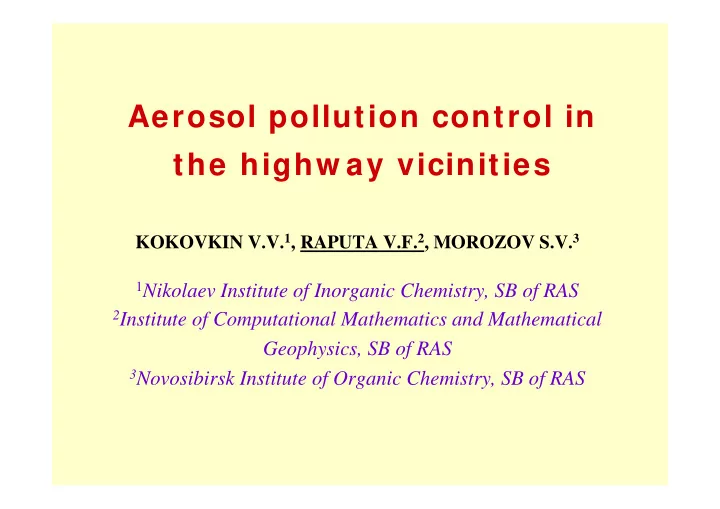

Aerosol pollution control in the highw ay vicinities KOKOVKIN V.V. 1 , RAPUTA V.F. 2 , MOROZOV S.V. 3 1 Nikolaev Institute of Inorganic Chemistry, SB of RAS 2 Institute of Computational Mathematics and Mathematical Geophysics, SB of RAS 3 Novosibirsk Institute of Organic Chemistry, SB of RAS
1. Sampling and chemical analysis methods of investigation
Snow sample Melting Melted sample Filtration Small size particles solid Liquid fraction (water Large size particles solid fraction (d ≥ 0.45 µ m) fraction (d ≥ 2 µ m) solution) Micro-elements content Macro-elements content Micro-elements content Atomic Emission Atomic Absorbance Analysis Method Analysis Method Zn, Fe, Mn, Al, Pb, Cu, Flame atomization Electrothermal Cd etc., 15-20 elements atomization Na, K, Mg, Ca, Zn Pb, Cu, Cd Conductivity Direct Capillary Titration Potentiometry electrophoresis specific Cl, NO3, SO4 hardness, Cl pH, alcalinity conductivity
2. Models of experimental data interpreting + 2 1 n M u H y = − − 1 P ( 1 ) q e xp + + ϕ π ϕ 2 2 2 2 k ( 1 n ) x 2 x ( 1 n ) k x 2 1 P 1 0 P 0 P = α − η β = − η β x sin , y b cos , P P η ∈ = β + β = − β + β ( , ) a x cos y sin , b x sin y cos L 1 L 2 α 2 y η − − η P P d ∫ ϕ ⋅ β = Θ ⋅ 2 2 x 2 x ( 2 ) q ( x , y , ) e P , 0 P Л 0 2 x L P 1
πη 2 P ∫ ∫ Θ Θ = Θ λ Θ ϕ + η ϕ ( , , , ) ( , ) ( , ) ( 180 o ) S x y q x y x R d d ( 3 ) 0 1 0 P P P 1 0 L 1 + 1 n M u H Θ = α = 1 , , + + ⋅ ⋅ ϕ ⋅ π 0 2 ( 1 n ) k ( 1 n ) k 2 1 1 0 ( 4 ) + β ≥ L , y x ctg L η = 2 2 + β P y x ctg w Θ λ Θ = Θ = ( x , ) x , , 1 + P 1 P 1 k ( n 1 ) 1 Θ α − Θ Θ = 0 ( 5 ) S ( x , , ) exp . + Θ 0 1 1 x 1 x
3. Experimental results а ) Lead Fig. 1. Specific content of lead in a large size particles solid fraction (a) and summarized small size solid fraction and liquid solution (b).
Fig. 2. Distribution of lead in the fractions of sample taken at 50 meter distance from the road: 1- liquid, 2 – small and 3 – large size particles solid fractions.
b) Polycyclic aromatic hydrocarbons (PAHs) Fig. 3. Calculated and measured specific content of benz(a)pyren in a snow cover of 1998-1999 and 1999-2000 winter ends
Table 1. Estimation of PAHs deposition values Estimation, М , g/km PAH 1998-1999 1999-2000 Benzo(a)pyrene 0,16 0,55 Fluoranthene 1,2 1,9 Pyrene 0,6 1,5
Fig. 4. Modeling curve for benzo(a)pyrene aerosol deposition in a highway vicinity of 2000-2001 winter season.
2007-2008 winter season
Fig. 5. Modeling curve for Fig. 6. Modeling curve for benzo(a)pyrene deposition in benzo(a)pyrene deposition in highway vicinities in 2003-2004 highway vicinities in 2007-2008 winter season. winter season.
Conclusion Analysis of data obtained showed that in 1999-2000 winter season the PAHs pollution was increased substantially. Aerosol particles PAHs contained also were grown. This means that less effective process of fuel firing in autotransport is used. The models presented were approved at the experimental data obtained on PAHs, different lead fractions and macro-component composition of snow samples. Analysis of data for 2003-2004 and 2007-2008 winter seasons showed substantial growth of PAHs pollution that concerns with number of cars growth in the city and its regime of movement.
Thanks for your attention
Recommend
More recommend